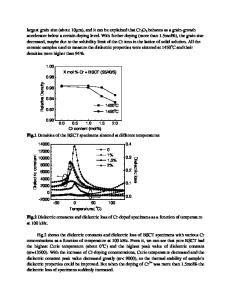Enhanced dielectric and tunable properties of Ba-doped (Pb,La)(Zr,Sn,Ti)O 3 antiferroelectric ceramics
- PDF / 803,673 Bytes
- 5 Pages / 595.276 x 790.866 pts Page_size
- 29 Downloads / 392 Views
Enhanced dielectric and tunable properties of Ba-doped (Pb,La) (Zr,Sn,Ti)O3 antiferroelectric ceramics Xiucai Wang1 · Weiqiang Cai2 · Ze Xiao2 · Xinmei Yu2 · Jianwen Chen2 · Tongqing Yang3 Received: 12 June 2020 / Accepted: 12 August 2020 © Springer Science+Business Media, LLC, part of Springer Nature 2020
Abstract In this work, a simple method to improve the dielectric tunability of antiferroelectric ceramics was introduced, and (Pb0.97−xLa0.02Bax)(Zr0.50Sn0.40Ti0.10)O3 (x = 0.08, 0.09, 0.10) antiferroelectric ceramics were prepared by conventional solidstate route. The effect of Ba-modification on phase structure and electric properties was systematically investigated. The results revealed that the barium content contributed to the decline of the Curie temperature and enhanced dielectric tunable performance. All compositions exhibited butterfly curve, and a high tunability of 48.89% at E AF and 53.02% at EFA was obtained in (Pb0.87La0.02Ba0.10)(Zr0.50Sn0.40Ti0.10)O3. In addition, the εmax/εmin ratio was up to 25.32, making it a promising candidate for nonlinear tunable devices.
1 Introduction Dielectric tunable materials have recently received renewal attention due to the potential applications in filters, phase shifters, wireless communications, etc. [1–3]. Antiferroelectric (AFE) materials are a subclass of dielectrics in which the orientations of the adjacent dipoles are alternately aligned in opposite directions, and no macroscopic spontaneous polarization exists [4]. The AFE phase can be transformed to the FE phase when the dc bias field is above the threshold electric field (EAF), and return to the AFE state when decreased to the threshold electric field (EFA) [5]. Meanwhile, the field-induced phase transition is known to bring about abrupt changes in macroscopic properties such as volume and dielectric constant, therefore AFEs is regarded as potential tunable materials, especially lanthanum-modified PZT known as PLZST [6, 7].
* Xinmei Yu [email protected] * Jianwen Chen [email protected] 1
School of Materials Science and Energy Engineering, Foshan University, Foshan 528000, China
2
School of Electronic and Information Engineering, Foshan University, Foshan 528000, China
3
College of Materials Science and Engineering, Tongji University, 4800 Cao’an Road, Shanghai 201804, China
Compared with the FE materials, there is less study about the dielectric nonlinearity for PLZST AFE ceramics, which can be induced by variations of temperature, electric field or pressure, and also with other elements modifications [8, 9]. Recently, Liu [10] showed a dielectric tunability of about 50.2% below 16.4 kV/mm of in P bZrO3 films related to the coexistence of FE and AFE phase. Peng [11] also reported higher tunability (75% at 56 kV/mm) in (111)-oriented relaxor Pb0.8Ba0.2ZrO3 thin film with AFE and FE two-phase coexistence. Especially, our co-worker [12] reported Bi-tunable dielectric constant of AFE PZT ceramics under the dc bias field, and dielectric constant not only increases, but also decreases unde
Data Loading...











